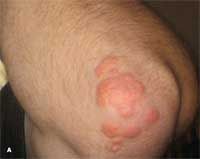- Clinical Technology
- Adult Immunization
- Hepatology
- Pediatric Immunization
- Screening
- Psychiatry
- Allergy
- Women's Health
- Cardiology
- Pediatrics
- Dermatology
- Endocrinology
- Pain Management
- Gastroenterology
- Infectious Disease
- Obesity Medicine
- Rheumatology
- Nephrology
- Neurology
- Pulmonology
Tuberous Xanthomas
During a routine physical examination, flesh-colored papules were noted on a 36-year-old man’s elbows, knees, and interphalangeal joints. The patient reported that they had been present for a long time, were nonpruritic, and had remained the same color and size. He had not self-treated with any over-the-counter medications. His only other concern was acid reflux for which he regularly took antacids. He had no significant medical or surgical history and no medication allergy. He smoked 1 pack of cigarettes per day, drank alcohol socially, and consumed caffeine-containing drinks daily.

During a routine physical examination, flesh-colored papules were noted on a 36-year-old man’s elbows, knees, and interphalangeal joints. The patient reported that they had been present for a long time, were nonpruritic, and had remained the same color and size. He had not self-treated with any over-the-counter medications. His only other concern was acid reflux for which he regularly took antacids. He had no significant medical or surgical history and no medication allergy. He smoked 1 pack of cigarettes per day, drank alcohol socially, and consumed caffeine-containing drinks daily.
Vital signs were stable. The location of the lesions (shown here on the elbow, A) and their yellow-orange hue were characteristic of tuberous xanthomas. Total cholesterol level was 746 mg/dL; triglyceride level, 1730 mg/dL; and high-density cholesterol level, 38 mg/dL. Low-density cholesterol was not calculable. The remainder of the laboratory results were normal.

Lipid-lowering therapy with atorvastatin (40 mg/d) and fenofibrate (145 mg/d) was started. After 3 months of treatment, the patient’s total cholesterol level declined to 239 mg/dL and triglyceride level to 554 mg/dL; however, the skin lesions persisted. Slow-release nicotinic acid was then added; however, because of flushing, the patient was unable to tolerate this medication, and the dosage of atorvastatin was increased to 80 mg/d. After 6 months of treatment, the xanthomas had resolved (B).
